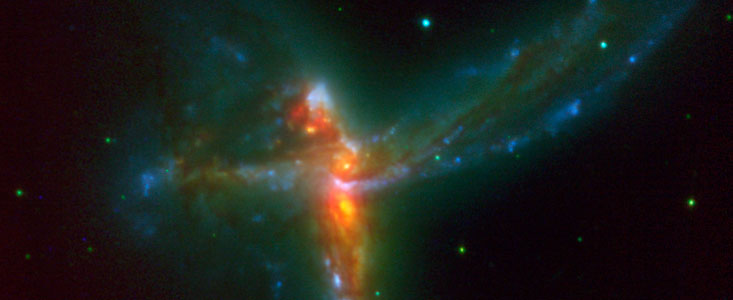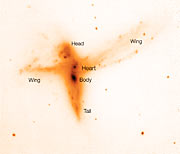Nota de prensa
COLISIÓN CON FORMA DE PÁJARO
21 de Diciembre de 2007
Usando El Very Large Telescope de ESO en Paranal, un equipo internacional de astrónomos descubrió un sorprendente caso de fusión triple de galaxias. Este sistema, compuesto por dos enormes galaxias espirales y una tercera galaxia irregular, fue apodado "el Pájaro" aunque también se asemeja al personaje "Campanita" de Peter Pan.
La galaxia ESO 593-IG 008, o IRAS 19115-2124, era conocida simplemente como un par de galaxias interactuando a una distancia de 650 millones de años-luz. Sin embargo el instrumento NACO del VLT de ESO, ubicado en la II Región de Chile, logró atravesar las nubes de polvo y resolver los detalles más finos gracias a la óptica adaptativa, revelando varias sorpresas.
Detrás del aspecto caótico de las imágenes ópticas del Hubble – recuperadas del archivo del Telescopio Espacial Hubble – las imágenes de NACO muestran dos galaxias inconfundibles, una espiral con forma de barra y otra más irregular.
Lo sorprendente fue identificar la presencia de un tercer componente nítidamente separado, una enorme galaxia irregular que parece estar formando estrellas a un ritmo frenético.
"Ejemplos de fusiones de tres galaxias de tamaños aproximadamente similares son muy escasos", dice Petri Väisänen, autor principal del artículo que informa sobre los resultados. "Solamente las observaciones en infrarrojo cercano del VLT hicieron posible identificar la naturaleza de fusión triple del sistema en este caso".
Debido a su semejanza con un ave, el sistema fue apodado "el Pájaro", donde la "cabeza" corresponde al tercer componente, y el "corazón" y "cuerpo" a los dos núcleos de galaxias mayores, ubicados entre las colas de mareas que serían las "alas", las que alcanzan una extensión de más de 100.000 años-luz, equivalente al tamaño de nuestra Vía Láctea.
La resolución alcanzada por NACO fue un décimo de arcosegundo, es decir, el ángulo formado por una moneda de 2 cm a una distancia de 40 km. Esto equivale a mejora en un factor de 600 lo que el ojo humano puede distinguir.
Espectroscopias ópticas posteriores realizadas con el nuevo Gran Telescopio Sudafricano, y datos en infrarrojo medio de los archivos del observatorio espacial Spitzer de la NASA, confirmaron la naturaleza independiente de la cabeza, pero también agregaron otras sorpresas.
La cabeza y el cuerpo del pájaro se están separando a más de 400 km/s (1,4 millones de km/h). Es muy raro ver velocidades tan altas en galaxias que se fusionan. Además, la cabeza parece ser la fuente principal de luminosidad infrarroja en el sistema, si bien es la más pequeña de las tres galaxias.
"Parece que NACO ha captado la acción justo en el momento del primer acercamiento a alta velocidad de la galaxia "cabeza" a través del sistema compuesto por las otras dos galaxias", dice Seppo Mattila, miembro del equipo que realizó el descubrimiento. "Estas dos galaxias se deben haber juntado anteriormente, probablemente hace un par de cientos de millones de años", explicó Mattila.
La cabeza está formando estrellas violentamente, a una velocidad de casi 200 masas solares por año, mientras las otras dos galaxias parecen estar en un período más tranquilo de su historia de formación estelar, motivada por la interacción.
El “Pájaro“ pertenece a la prestigiosa familia de galaxias infrarrojas luminosas, con una luminosidad infrarroja casi mil millones de veces la del Sol. Durante mucho tiempo se pensó que esta familia de galaxias marca importantes acontecimientos en la evolución, tales como fusiones de galaxias, que a su vez desencadenan explosiones de formación de estrellas que pueden conducir finalmente a la formación de una única galaxia elíptica.
Las conclusiones de este estudio serán publicadas en la revista Monthly Notices of the Royal Astronomical Society ("Imágenes con óptica adaptativa y espectroscopia óptica de una fusión múltiple en una galaxia infrarroja luminosa", por P. Väisänen" y otros).
El equipo de investigadores está compuesto por P. Väisänen, A. Kniazev, D. A. H. Buckley, L. Crause, Y. Hashimoto, N. Loaring, E. Romero-Colmenero y M. Still (Observatorio Astronómico Sudafricano, Sudáfrica); S. Mattila (Observatorio Tuorla, Finlandia); A. Adamo y G. Östlin (Universidad de Estocolmo, Suecia); A. Efstathiou (Universidad de Chipre, Nicosia, Chipre); D. Farrah (Universidad Cornell, EE.UU.); P. H. Johansson (Observatorio de la Universidad de Munich, Alemania); E. B. Burgh y K. Nordsieck (Universidad de Wisconsin, EE.UU.); P. Lira (Universidad de Chile, Santiago, Chile); A. Zijlstra (Universidad de Manchester, Reino Unido); y S. Ryder (Observatorio Anglo-Australiano, Australia).
Contactos
Valentina Rodríguez
Encargada de Prensa de ESO en Chile
Santiago, Chile
Tlf.: +56 2 463 3123
Celular:
Email: vrodrigu@eso.org
Petri Väisänen
South African Astronomical Observatory
Cape Town, South Africa
Tlf.: +27-21-460-9354
Celular: +27-72-463-3426
Email: petri@saao.ac.za
Seppo Mattila
Tuorla Observatory
Turku, Finland
Tlf.: +358 2 333 8299
Email: seppo.mattila@utu.fi
Acerca de la nota de prensa
| Nota de prensa No.: | eso0755es-cl |
| Legacy ID: | PR 55/07 |
| Nombre: | ESO 593-IG 008, IRAS 19115-2124 |
| Tipo: | Local Universe : Galaxy : Type : Interacting |
| Facility: | Very Large Telescope |
| Instruments: | NACO |


